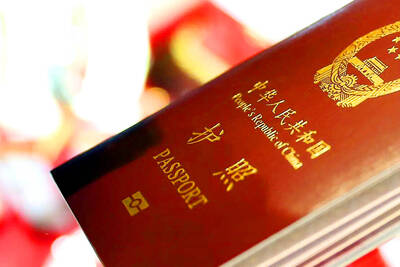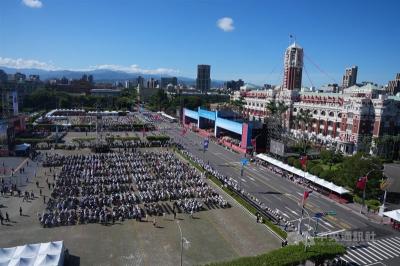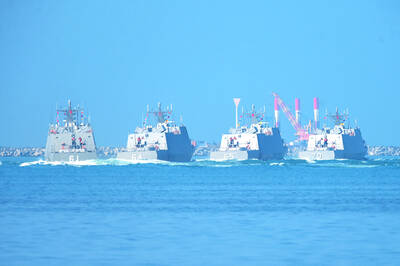Australia yesterday unveiled its first National Defence Strategy, signaling a new focus on deterring China’s “coercive tactics” in the Indo-Pacific region.
The 80-page document offers a gloomy assessment of Pacific security and sets out a massive increase in defense spending to retool Australia’s military to cope with the challenge.
“The optimistic assumptions that guided defense planning after the end of the Cold War are long gone,” Australian Minister for Defence Richard Marles said as he presented the new strategy.
Warning that “China has employed coercive tactics in pursuit of its strategic objectives,” the text describes an Australia vulnerable to foes strangling trade or preventing access to vital air and sea routes.
“We are a maritime trading island nation,” Marles said. “The invasion of Australia is an unlikely prospect in any scenario, precisely because so much damage can be done to our country by an adversary without ever having to step foot on Australian soil.”
Instead of focusing on maintaining a military that can do a range of tasks almost anywhere in the world, Marles said the focus would be on building a force that can protect Australia’s interests in its immediate region.
At the center of the strategy are plans to develop a fleet of stealth nuclear-powered submarines to triple key missile capabilities and develop a large surface combatant fleet.
“Having the most capable navy in our history will be at the heart of our projection and our strategy of denial,” Marles said.
As a share of GDP, defense spending is set to increase from about 2 percent now to 2.4 percent within a decade.
Australia predicted increased risk of conflict in the Taiwan Strait, the South and East China seas, or on the Indian border.
Marles said that old assumptions about how much time Australia would have to prepare for war were gone.
“Australia no longer has the luxury of a 10-year window of strategic warning time for conflict,” he said.
Asked about Canberra’s strategy at a regular briefing, Beijing urged Australia to “refrain from making accusations against China at every turn.”
“China poses no threat to any country,” Chinese Ministry of Foreign Affairs spokesman Lin Jian (林劍) said. “We hope that the Australian side can view China’s development and strategic intentions in a correct light, abandon the Cold War mentality [and] do more to safeguard regional peace and stability.”

The Ministry of the Interior (MOI) is to tighten rules for candidates running for public office, requiring them to declare that they do not hold a Chinese household registration or passport, and that they possess no other foreign citizenship. The requirement was set out in a draft amendment to the Enforcement Rules of the Public Officials Election and Recall Act (公職人員選舉罷免法 ) released by the ministry on Thursday. Under the proposal, candidates would need to make the declaration when submitting their registration forms, which would be published in the official election bulletin. The move follows the removal of several elected officials who were

The Republic of China (ROC) is celebrating its 114th Double Ten National Day today, featuring military parades and a variety of performances and speeches in front of the Presidential Office in Taipei. The Taiwan Taiko Association opened the celebrations with a 100-drummer performance, including young percussionists. As per tradition, an air force Mirage 2000 fighter jet flew over the Presidential Office as a part of the performance. The Honor Guards of the ROC and its marching band also heralded in a military parade. Students from Taichung's Shin Min High School then followed with a colorful performance using floral imagery to represent Taiwan's alternate name

FOUR DESIGNATED AREAS: Notices were issued for live-fire exercises in waters south and northwest of Penghu, northeast of Keelung and west of Kaohsiung, they said The military is planning three major annual exercises across the army, navy and air force this month, with the navy’s “Hai Chiang” (海強, “Sea Strong”) drills running from today through Thursday, the Ministry of National Defense said yesterday. The Hai Chiang exercise, which is to take place in waters surrounding Taiwan, would feature P-3C Orion maritime patrol aircraft and S-70C anti-submarine helicopters, the ministry said, adding that the drills aim to bolster the nation’s offshore defensive capabilities. China has intensified military and psychological pressure against Taiwan, repeatedly sending warplanes and vessels into areas near the nation’s air defense identification zone and across

COVETED PRIZE: The US president would be a peace prize laureate should he persuade Xi Jinping to abandon military aggression against Taiwan, William Lai said US President Donald Trump should get the Nobel Peace Prize should he be able to convince Chinese President Xi Jinping (習近平) to abandon the use of force against Taiwan, President William Lai (賴清德) told a conservative US radio show and podcast in an interview. The US is Taiwan’s most important international backer, despite the absence of formal ties, but since Trump took office earlier this year he has not announced any new arms sales to the nation. Trump could meet Xi at the APEC summit in South Korea on Oct. 31 and Nov. 1. Lai, speaking on The Clay Travis and Buck Sexton